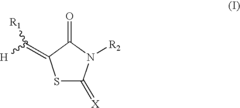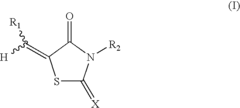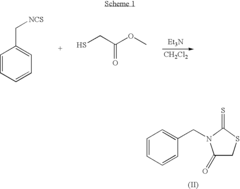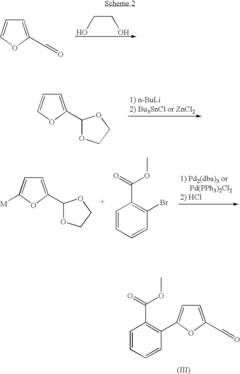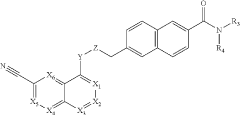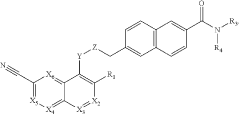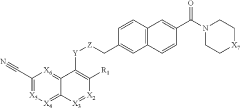How Alkyls Influence Medicinal Chemistry Developments?
JUL 15, 20259 MIN READ
Generate Your Research Report Instantly with AI Agent
Patsnap Eureka helps you evaluate technical feasibility & market potential.
Alkyl Groups in Drug Design: Background and Objectives
Alkyl groups have played a pivotal role in the evolution of medicinal chemistry, significantly influencing drug design and development over the past century. These hydrocarbon moieties, characterized by their saturated carbon chains, have become fundamental building blocks in the creation of pharmaceutically active compounds. The journey of alkyl groups in drug design began with the recognition of their impact on molecular properties, such as lipophilicity, solubility, and metabolic stability.
The primary objective in exploring alkyl groups within medicinal chemistry is to enhance the efficacy and safety profiles of potential drug candidates. Researchers aim to leverage the unique properties of alkyl substituents to modulate drug-like characteristics, including absorption, distribution, metabolism, and excretion (ADME) properties. By strategically incorporating alkyl groups into molecular structures, medicinal chemists seek to optimize pharmacokinetic parameters and improve target engagement.
Throughout the history of drug discovery, alkyl groups have demonstrated their versatility in addressing various challenges. They have been instrumental in fine-tuning the binding affinity of ligands to their target proteins, altering the electronic properties of functional groups, and influencing the overall three-dimensional structure of drug molecules. The ability of alkyl groups to modulate these critical aspects has made them indispensable tools in the medicinal chemist's arsenal.
The evolution of alkyl group utilization in drug design has been marked by several key milestones. Early applications focused primarily on simple modifications, such as methylation or ethylation, to improve drug absorption or metabolic stability. As the field progressed, more sophisticated approaches emerged, including the use of branched alkyl groups, cycloalkyl moieties, and stereospecific alkyl substitutions to achieve desired pharmacological effects.
Recent advancements in computational chemistry and structure-based drug design have further expanded the potential of alkyl groups in medicinal chemistry. These tools have enabled researchers to predict and rationalize the impact of alkyl substituents on molecular properties and biological activity with unprecedented accuracy. This has led to more targeted and efficient drug design strategies, where alkyl groups are employed not just as modifiers of physicochemical properties, but as key determinants of molecular recognition and specificity.
Looking ahead, the exploration of alkyl groups in medicinal chemistry continues to evolve. Emerging trends include the investigation of novel alkyl architectures, such as spirocyclic systems and polycyclic alkyl cages, which offer unique three-dimensional shapes and properties. Additionally, there is growing interest in leveraging alkyl groups for targeted drug delivery and controlled release formulations, further expanding their role in pharmaceutical development.
The primary objective in exploring alkyl groups within medicinal chemistry is to enhance the efficacy and safety profiles of potential drug candidates. Researchers aim to leverage the unique properties of alkyl substituents to modulate drug-like characteristics, including absorption, distribution, metabolism, and excretion (ADME) properties. By strategically incorporating alkyl groups into molecular structures, medicinal chemists seek to optimize pharmacokinetic parameters and improve target engagement.
Throughout the history of drug discovery, alkyl groups have demonstrated their versatility in addressing various challenges. They have been instrumental in fine-tuning the binding affinity of ligands to their target proteins, altering the electronic properties of functional groups, and influencing the overall three-dimensional structure of drug molecules. The ability of alkyl groups to modulate these critical aspects has made them indispensable tools in the medicinal chemist's arsenal.
The evolution of alkyl group utilization in drug design has been marked by several key milestones. Early applications focused primarily on simple modifications, such as methylation or ethylation, to improve drug absorption or metabolic stability. As the field progressed, more sophisticated approaches emerged, including the use of branched alkyl groups, cycloalkyl moieties, and stereospecific alkyl substitutions to achieve desired pharmacological effects.
Recent advancements in computational chemistry and structure-based drug design have further expanded the potential of alkyl groups in medicinal chemistry. These tools have enabled researchers to predict and rationalize the impact of alkyl substituents on molecular properties and biological activity with unprecedented accuracy. This has led to more targeted and efficient drug design strategies, where alkyl groups are employed not just as modifiers of physicochemical properties, but as key determinants of molecular recognition and specificity.
Looking ahead, the exploration of alkyl groups in medicinal chemistry continues to evolve. Emerging trends include the investigation of novel alkyl architectures, such as spirocyclic systems and polycyclic alkyl cages, which offer unique three-dimensional shapes and properties. Additionally, there is growing interest in leveraging alkyl groups for targeted drug delivery and controlled release formulations, further expanding their role in pharmaceutical development.
Market Demand for Alkyl-Modified Drugs
The market demand for alkyl-modified drugs has been steadily increasing in recent years, driven by the growing recognition of their potential to enhance drug efficacy and safety profiles. Alkyl modifications play a crucial role in medicinal chemistry by altering the physicochemical properties of drug molecules, which can lead to improved pharmacokinetics, increased potency, and reduced side effects.
One of the primary drivers of market demand is the ability of alkyl modifications to enhance drug absorption and distribution. By manipulating the lipophilicity of drug molecules through alkyl group additions or substitutions, pharmaceutical companies can develop drugs with improved oral bioavailability and better tissue penetration. This is particularly valuable for drugs targeting the central nervous system, where crossing the blood-brain barrier is a significant challenge.
The oncology sector has shown particularly strong interest in alkyl-modified drugs. Many anticancer agents benefit from alkyl modifications that can improve their ability to reach tumor sites and increase their residence time within cancer cells. This has led to the development of more effective and targeted therapies, driving demand in the rapidly growing cancer treatment market.
In the field of antibiotics, alkyl modifications have proven effective in combating drug resistance. By altering the structure of existing antibiotics with strategic alkyl group placements, researchers have been able to create new variants that can overcome bacterial resistance mechanisms. This has sparked renewed interest from pharmaceutical companies looking to extend the life cycle of their antibiotic portfolios and address the global threat of antimicrobial resistance.
The market for alkyl-modified drugs also extends to the treatment of chronic diseases such as diabetes and cardiovascular disorders. Alkyl modifications can improve the half-life of drugs, allowing for less frequent dosing and potentially improving patient compliance. This is particularly valuable in long-term treatment regimens where patient adherence is crucial for therapeutic success.
Furthermore, the demand for alkyl-modified drugs is being fueled by advancements in drug delivery systems. Alkyl modifications can be used to create prodrugs that are more easily absorbed and then metabolized into the active compound within the body. This approach has opened up new possibilities for delivering drugs that were previously limited by poor solubility or stability.
As the pharmaceutical industry continues to face challenges in developing new chemical entities, the modification of existing drugs through alkylation presents a cost-effective strategy for creating improved therapies. This has led to increased investment in research and development focused on alkyl modifications, further driving market demand for these innovative drug formulations.
One of the primary drivers of market demand is the ability of alkyl modifications to enhance drug absorption and distribution. By manipulating the lipophilicity of drug molecules through alkyl group additions or substitutions, pharmaceutical companies can develop drugs with improved oral bioavailability and better tissue penetration. This is particularly valuable for drugs targeting the central nervous system, where crossing the blood-brain barrier is a significant challenge.
The oncology sector has shown particularly strong interest in alkyl-modified drugs. Many anticancer agents benefit from alkyl modifications that can improve their ability to reach tumor sites and increase their residence time within cancer cells. This has led to the development of more effective and targeted therapies, driving demand in the rapidly growing cancer treatment market.
In the field of antibiotics, alkyl modifications have proven effective in combating drug resistance. By altering the structure of existing antibiotics with strategic alkyl group placements, researchers have been able to create new variants that can overcome bacterial resistance mechanisms. This has sparked renewed interest from pharmaceutical companies looking to extend the life cycle of their antibiotic portfolios and address the global threat of antimicrobial resistance.
The market for alkyl-modified drugs also extends to the treatment of chronic diseases such as diabetes and cardiovascular disorders. Alkyl modifications can improve the half-life of drugs, allowing for less frequent dosing and potentially improving patient compliance. This is particularly valuable in long-term treatment regimens where patient adherence is crucial for therapeutic success.
Furthermore, the demand for alkyl-modified drugs is being fueled by advancements in drug delivery systems. Alkyl modifications can be used to create prodrugs that are more easily absorbed and then metabolized into the active compound within the body. This approach has opened up new possibilities for delivering drugs that were previously limited by poor solubility or stability.
As the pharmaceutical industry continues to face challenges in developing new chemical entities, the modification of existing drugs through alkylation presents a cost-effective strategy for creating improved therapies. This has led to increased investment in research and development focused on alkyl modifications, further driving market demand for these innovative drug formulations.
Current Challenges in Alkyl-Based Medicinal Chemistry
The field of alkyl-based medicinal chemistry faces several significant challenges that hinder progress and limit the potential for new drug discoveries. One of the primary obstacles is the inherent reactivity of alkyl groups, which can lead to undesired side reactions and metabolic instability in drug candidates. This reactivity often results in compounds with poor pharmacokinetic profiles, making it difficult to achieve optimal drug-like properties.
Another major challenge is the limited diversity of available alkyl building blocks. While there is a vast array of aromatic and heteroaromatic structures commonly used in drug design, the repertoire of alkyl fragments is comparatively restricted. This limitation constrains the exploration of chemical space and potentially overlooks valuable therapeutic opportunities.
The optimization of alkyl-containing compounds presents unique difficulties in terms of structure-activity relationships (SAR). Unlike aromatic systems, where substituent effects are well-understood, the impact of alkyl modifications on biological activity can be less predictable. This unpredictability complicates the rational design process and often necessitates extensive empirical testing.
Synthetic accessibility remains a significant hurdle in alkyl-based medicinal chemistry. Many desirable alkyl modifications require multi-step syntheses or involve challenging carbon-carbon bond formations. These synthetic complexities can slow down the drug discovery process and increase development costs.
The incorporation of alkyl groups often affects the physicochemical properties of drug candidates in ways that are difficult to anticipate. Issues such as poor solubility, high lipophilicity, and reduced target binding affinity frequently arise, necessitating careful balancing of molecular properties throughout the optimization process.
Stereochemistry presents another layer of complexity in alkyl-based drug design. The three-dimensional arrangement of alkyl substituents can significantly impact a compound's biological activity and ADME properties. However, controlling and analyzing stereochemistry in complex alkyl systems can be technically challenging and resource-intensive.
Lastly, the pharmaceutical industry faces regulatory challenges related to the metabolic fate of alkyl-containing drugs. Concerns about potentially toxic metabolites and long-term safety profiles of drugs with extensive alkyl modifications have led to increased scrutiny during the drug approval process. This regulatory environment necessitates more comprehensive metabolic studies and safety assessments, further complicating the development of alkyl-based therapeutics.
Another major challenge is the limited diversity of available alkyl building blocks. While there is a vast array of aromatic and heteroaromatic structures commonly used in drug design, the repertoire of alkyl fragments is comparatively restricted. This limitation constrains the exploration of chemical space and potentially overlooks valuable therapeutic opportunities.
The optimization of alkyl-containing compounds presents unique difficulties in terms of structure-activity relationships (SAR). Unlike aromatic systems, where substituent effects are well-understood, the impact of alkyl modifications on biological activity can be less predictable. This unpredictability complicates the rational design process and often necessitates extensive empirical testing.
Synthetic accessibility remains a significant hurdle in alkyl-based medicinal chemistry. Many desirable alkyl modifications require multi-step syntheses or involve challenging carbon-carbon bond formations. These synthetic complexities can slow down the drug discovery process and increase development costs.
The incorporation of alkyl groups often affects the physicochemical properties of drug candidates in ways that are difficult to anticipate. Issues such as poor solubility, high lipophilicity, and reduced target binding affinity frequently arise, necessitating careful balancing of molecular properties throughout the optimization process.
Stereochemistry presents another layer of complexity in alkyl-based drug design. The three-dimensional arrangement of alkyl substituents can significantly impact a compound's biological activity and ADME properties. However, controlling and analyzing stereochemistry in complex alkyl systems can be technically challenging and resource-intensive.
Lastly, the pharmaceutical industry faces regulatory challenges related to the metabolic fate of alkyl-containing drugs. Concerns about potentially toxic metabolites and long-term safety profiles of drugs with extensive alkyl modifications have led to increased scrutiny during the drug approval process. This regulatory environment necessitates more comprehensive metabolic studies and safety assessments, further complicating the development of alkyl-based therapeutics.
Existing Strategies for Alkyl Incorporation in Drugs
01 Synthesis of alkyl compounds
Various methods for synthesizing alkyl compounds are described, including reactions involving alkyl halides, alcohols, and other precursors. These processes often involve catalysts and specific reaction conditions to produce desired alkyl derivatives.- Synthesis of alkyl compounds: Various methods for synthesizing alkyl compounds are described, including reactions involving alkyl halides, alcohols, and other precursors. These processes often involve catalysts and specific reaction conditions to produce desired alkyl derivatives.
- Alkyl-based catalysts: Alkyl compounds are used as catalysts or components of catalytic systems in various chemical processes. These catalysts can facilitate reactions such as polymerization, isomerization, and other organic transformations.
- Alkyl derivatives in petroleum industry: Alkyl compounds and their derivatives find applications in the petroleum industry, including use as additives in fuels and lubricants. They can improve the performance and properties of petroleum products.
- Alkyl-based polymers and materials: Alkyl groups are incorporated into polymers and materials to modify their properties. This includes the development of alkyl-based plastics, resins, and other synthetic materials with specific characteristics.
- Environmental and safety considerations of alkyls: Research on the environmental impact and safety aspects of alkyl compounds is conducted. This includes studies on biodegradability, toxicity, and potential hazards associated with the production and use of alkyl-based substances.
02 Alkyl-based catalysts
Alkyl compounds are used as catalysts or components of catalytic systems in various chemical processes. These catalysts can facilitate reactions such as polymerization, isomerization, and other organic transformations.Expand Specific Solutions03 Alkyl derivatives in petroleum industry
Alkyl compounds and their derivatives find applications in the petroleum industry, including use as additives in fuels and lubricants, as well as in oil recovery processes. These compounds can improve the performance and efficiency of petroleum products.Expand Specific Solutions04 Alkyl-substituted aromatic compounds
Methods for preparing alkyl-substituted aromatic compounds are described, involving various alkylation processes. These compounds have applications in the production of fine chemicals, pharmaceuticals, and other industrial products.Expand Specific Solutions05 Alkyl halides and their reactions
Processes involving alkyl halides, including their preparation and reactions, are discussed. These compounds serve as important intermediates in organic synthesis and can undergo various transformations to produce other valuable alkyl derivatives.Expand Specific Solutions
Key Players in Alkyl-Focused Medicinal Chemistry
The field of medicinal chemistry focusing on alkyl influences is in a mature stage of development, with a substantial market size driven by the pharmaceutical industry's continuous need for novel drug candidates. The technology's maturity is evident from the involvement of major players like Janssen Pharmaceutica NV, PTC Therapeutics, and Biogen MA, Inc., who have established research programs and product pipelines leveraging alkyl modifications. The competitive landscape is diverse, with both large pharmaceutical companies and specialized biotech firms like Paratek Pharmaceuticals and Betta Pharmaceuticals Co., Ltd. actively contributing to advancements. This technological area continues to evolve, with ongoing research aimed at optimizing drug properties and expanding therapeutic applications across various disease areas.
Janssen Pharmaceutica NV
Technical Solution: Janssen Pharmaceutica NV has developed a comprehensive approach to alkyl influence in medicinal chemistry. They utilize structure-activity relationship (SAR) studies to optimize alkyl substituents for enhanced drug potency and selectivity. Their research focuses on the impact of alkyl chain length and branching on pharmacokinetic properties, particularly lipophilicity and metabolic stability[1]. Janssen employs computational modeling to predict alkyl effects on protein-ligand interactions, guiding rational drug design. They have successfully applied this approach in developing novel kinase inhibitors and G-protein coupled receptor (GPCR) modulators[3].
Strengths: Extensive experience in SAR studies, advanced computational modeling capabilities. Weaknesses: Potential over-reliance on in silico predictions, which may not always translate to in vivo efficacy.
Sanofi-Aventis SA
Technical Solution: Sanofi-Aventis has implemented a comprehensive alkyl modification strategy in their medicinal chemistry efforts. They focus on the systematic exploration of alkyl chain length, branching, and substitution patterns to optimize drug-like properties. Sanofi's approach includes the use of deuterated alkyls to modulate metabolic stability and pharmacokinetics[7]. They have developed a proprietary database of alkyl effects on various molecular scaffolds, which guides their drug design process. This strategy has been particularly effective in their diabetes and cardiovascular research programs, leading to the development of several compounds with improved oral bioavailability and extended half-lives[8].
Strengths: Extensive database of alkyl effects, innovative use of deuterated alkyls. Weaknesses: Potential limitations in applying historical data to novel chemical spaces.
Innovative Alkyl Modifications in Recent Drug Patents
Use of Thiazolidinone Derivatives as Antiangiogenic Agents
PatentInactiveUS20080261980A1
Innovation
- Thiazolidinone compounds that inhibit the interaction between HIF-1α and p300, preventing VEGF production in tumor cells, are developed and synthesized, offering a pharmacological approach to control angiogenesis and tumor growth.
Novel CDK 8/19 inhibitors
PatentInactiveUS20220098160A1
Innovation
- Development of specific compounds, such as those represented by formulas I, II, and III, which inhibit the biological activity of CDK8/19 by interacting with these kinases, potentially used in pharmaceutical compositions for treating cancers mediated by CDK8/19 activation.
Regulatory Considerations for Alkyl-Modified Drugs
The regulatory landscape for alkyl-modified drugs is complex and evolving, requiring careful consideration throughout the drug development process. Regulatory bodies, such as the FDA and EMA, have established specific guidelines for the evaluation and approval of these compounds, focusing on their unique chemical properties and potential impacts on safety and efficacy.
One of the primary regulatory considerations for alkyl-modified drugs is the assessment of their pharmacokinetic and pharmacodynamic profiles. Regulatory agencies require comprehensive data on how alkyl modifications affect drug absorption, distribution, metabolism, and excretion. This information is crucial for determining appropriate dosing regimens and potential drug-drug interactions.
Safety evaluations for alkyl-modified drugs are particularly stringent, with regulatory bodies demanding extensive toxicology studies. These studies must address potential off-target effects, metabolic stability, and long-term safety concerns associated with the alkyl modifications. Regulatory agencies may require additional studies to assess the impact of alkyl groups on organ systems, particularly the liver and kidneys.
The manufacturing process for alkyl-modified drugs is subject to rigorous regulatory scrutiny. Good Manufacturing Practices (GMP) guidelines must be strictly adhered to, with special attention given to the purity and stability of the alkyl-modified compounds. Regulatory bodies often require detailed information on the synthetic routes, impurity profiles, and quality control measures employed in the production of these drugs.
Intellectual property considerations also play a significant role in the regulatory landscape for alkyl-modified drugs. Patent protection strategies must be carefully aligned with regulatory requirements to ensure market exclusivity and prevent potential infringement issues. This often involves close collaboration between regulatory affairs teams and patent attorneys.
Clinical trial designs for alkyl-modified drugs may require specific regulatory approvals, particularly if the alkyl modifications are expected to significantly alter the drug's behavior in vivo. Regulatory agencies may demand more extensive Phase I studies to establish safety profiles and dose-ranging data before progressing to later-stage trials.
Labeling and post-marketing surveillance requirements for alkyl-modified drugs are often more stringent than those for conventional drugs. Regulatory bodies may mandate specific warnings or contraindications related to the alkyl modifications, as well as long-term follow-up studies to monitor for potential delayed adverse effects.
As the field of medicinal chemistry continues to advance, regulatory frameworks are adapting to keep pace with innovations in alkyl-modified drugs. This dynamic regulatory environment necessitates ongoing dialogue between drug developers and regulatory agencies to ensure that novel alkyl-modified compounds can be efficiently and safely brought to market.
One of the primary regulatory considerations for alkyl-modified drugs is the assessment of their pharmacokinetic and pharmacodynamic profiles. Regulatory agencies require comprehensive data on how alkyl modifications affect drug absorption, distribution, metabolism, and excretion. This information is crucial for determining appropriate dosing regimens and potential drug-drug interactions.
Safety evaluations for alkyl-modified drugs are particularly stringent, with regulatory bodies demanding extensive toxicology studies. These studies must address potential off-target effects, metabolic stability, and long-term safety concerns associated with the alkyl modifications. Regulatory agencies may require additional studies to assess the impact of alkyl groups on organ systems, particularly the liver and kidneys.
The manufacturing process for alkyl-modified drugs is subject to rigorous regulatory scrutiny. Good Manufacturing Practices (GMP) guidelines must be strictly adhered to, with special attention given to the purity and stability of the alkyl-modified compounds. Regulatory bodies often require detailed information on the synthetic routes, impurity profiles, and quality control measures employed in the production of these drugs.
Intellectual property considerations also play a significant role in the regulatory landscape for alkyl-modified drugs. Patent protection strategies must be carefully aligned with regulatory requirements to ensure market exclusivity and prevent potential infringement issues. This often involves close collaboration between regulatory affairs teams and patent attorneys.
Clinical trial designs for alkyl-modified drugs may require specific regulatory approvals, particularly if the alkyl modifications are expected to significantly alter the drug's behavior in vivo. Regulatory agencies may demand more extensive Phase I studies to establish safety profiles and dose-ranging data before progressing to later-stage trials.
Labeling and post-marketing surveillance requirements for alkyl-modified drugs are often more stringent than those for conventional drugs. Regulatory bodies may mandate specific warnings or contraindications related to the alkyl modifications, as well as long-term follow-up studies to monitor for potential delayed adverse effects.
As the field of medicinal chemistry continues to advance, regulatory frameworks are adapting to keep pace with innovations in alkyl-modified drugs. This dynamic regulatory environment necessitates ongoing dialogue between drug developers and regulatory agencies to ensure that novel alkyl-modified compounds can be efficiently and safely brought to market.
Environmental Impact of Alkyl-Based Drug Synthesis
The environmental impact of alkyl-based drug synthesis is a critical consideration in the development of medicinal chemistry. As the pharmaceutical industry continues to grow, the need for sustainable and environmentally friendly synthesis methods becomes increasingly important. Alkyl groups, which are commonly used in drug molecules, play a significant role in determining the environmental footprint of drug production processes.
One of the primary environmental concerns associated with alkyl-based drug synthesis is the generation of hazardous waste. Many traditional synthesis methods involve the use of toxic solvents, catalysts, and reagents that can have detrimental effects on ecosystems if not properly managed. These chemicals may persist in the environment, contaminating soil and water sources, and potentially harming wildlife and human health.
Furthermore, the production of alkyl-containing compounds often requires energy-intensive processes, contributing to increased carbon emissions and climate change. The use of fossil fuel-derived starting materials in alkyl synthesis also raises sustainability concerns, as these resources are finite and their extraction can lead to environmental degradation.
However, recent advancements in green chemistry have led to the development of more environmentally friendly approaches to alkyl-based drug synthesis. These include the use of renewable feedstocks, such as biomass-derived alkyl sources, which can reduce reliance on petrochemicals and minimize carbon footprints. Additionally, the implementation of catalytic processes that operate under milder conditions and with higher atom economy can significantly reduce waste generation and energy consumption.
The pharmaceutical industry has also been exploring alternative reaction media, such as water, supercritical fluids, and ionic liquids, to replace traditional organic solvents in alkyl-based syntheses. These novel approaches not only reduce the environmental impact but also often lead to improved reaction efficiencies and product yields.
Continuous flow chemistry is another promising technology that can enhance the sustainability of alkyl-based drug synthesis. By enabling precise control over reaction parameters and facilitating the use of smaller quantities of reagents, continuous flow processes can minimize waste production and improve overall process efficiency.
As regulatory bodies worldwide continue to tighten environmental standards, pharmaceutical companies are increasingly investing in life cycle assessments and green metrics to evaluate and improve the environmental performance of their alkyl-based drug synthesis processes. This holistic approach considers factors such as resource depletion, ecotoxicity, and global warming potential throughout the entire product lifecycle.
In conclusion, while alkyl-based drug synthesis has historically posed significant environmental challenges, ongoing research and technological advancements are paving the way for more sustainable practices in medicinal chemistry. By addressing the environmental impact of these processes, the pharmaceutical industry can contribute to global sustainability goals while continuing to develop innovative and effective medications.
One of the primary environmental concerns associated with alkyl-based drug synthesis is the generation of hazardous waste. Many traditional synthesis methods involve the use of toxic solvents, catalysts, and reagents that can have detrimental effects on ecosystems if not properly managed. These chemicals may persist in the environment, contaminating soil and water sources, and potentially harming wildlife and human health.
Furthermore, the production of alkyl-containing compounds often requires energy-intensive processes, contributing to increased carbon emissions and climate change. The use of fossil fuel-derived starting materials in alkyl synthesis also raises sustainability concerns, as these resources are finite and their extraction can lead to environmental degradation.
However, recent advancements in green chemistry have led to the development of more environmentally friendly approaches to alkyl-based drug synthesis. These include the use of renewable feedstocks, such as biomass-derived alkyl sources, which can reduce reliance on petrochemicals and minimize carbon footprints. Additionally, the implementation of catalytic processes that operate under milder conditions and with higher atom economy can significantly reduce waste generation and energy consumption.
The pharmaceutical industry has also been exploring alternative reaction media, such as water, supercritical fluids, and ionic liquids, to replace traditional organic solvents in alkyl-based syntheses. These novel approaches not only reduce the environmental impact but also often lead to improved reaction efficiencies and product yields.
Continuous flow chemistry is another promising technology that can enhance the sustainability of alkyl-based drug synthesis. By enabling precise control over reaction parameters and facilitating the use of smaller quantities of reagents, continuous flow processes can minimize waste production and improve overall process efficiency.
As regulatory bodies worldwide continue to tighten environmental standards, pharmaceutical companies are increasingly investing in life cycle assessments and green metrics to evaluate and improve the environmental performance of their alkyl-based drug synthesis processes. This holistic approach considers factors such as resource depletion, ecotoxicity, and global warming potential throughout the entire product lifecycle.
In conclusion, while alkyl-based drug synthesis has historically posed significant environmental challenges, ongoing research and technological advancements are paving the way for more sustainable practices in medicinal chemistry. By addressing the environmental impact of these processes, the pharmaceutical industry can contribute to global sustainability goals while continuing to develop innovative and effective medications.
Unlock deeper insights with Patsnap Eureka Quick Research — get a full tech report to explore trends and direct your research. Try now!
Generate Your Research Report Instantly with AI Agent
Supercharge your innovation with Patsnap Eureka AI Agent Platform!
